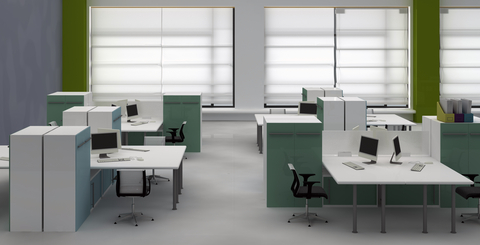As work environments evolve, driven by the desire to realise company productivity and efficiency gains, offices or workspaces are now becoming increasingly activity-based rather than just somewhere you go to complete daily work tasks.

With more and more work taking place outside of the office and even outside normal working hours, it might be time to look at how your own office functions and perhaps even find new ways to introduce flexibility into your company. The concept of ‘workshifting’ has become a popular choice for many companies; allowing employees to move their work to more convenient times and locations.
While it is no secret that the office is turning to more mobile solutions, there are so many factors involved in successfully switching the workplace to a more digital and flexible environment. So what does it take to achieve a fresh, revolutionary way of working? Here we take a look at the technology, culture changes and ideas that are necessary to achieve the next-gen workplace.
Workshifting Trend
Moving your workspace to a place that is more convenient, as well as completing work when it is best for you is now becoming increasingly popular. Citrix sponsored a recent survey which revealed today’s workers around the world use an average of 6 communication devices to do work, spending only two thirds of the working week actually at their desk. With this in mind, it is clear that the workplace is not quite so rigid anymore. 91% of organisations plan to have a more mobile work style strategy; they expect employees will work at their home, project sites or partner sites.
To achieve such an environment, companies will need to create a system based on flexible policies along with collaboration, community building and the relevant technology to allow employees to work when and how they want.
Technology’s Role
Having a work environment of this kind is only successful if you have the right tools to keep productivity and communication consistent. A survey carried out by CareerArc showed that 45% of participants did not feel like they had enough time for personal activities, with 20% of participants completing more than 20 hours of work per week during personal time. Creating a more flexible and convenient strategy could play a part in restoring a work-life balance; the technology you use is crucial for this.
A BYOD, or Bring Your Own Device, policy is something that often divides the opinion of business leaders. Allowing employees to use their own devices for work purposes can increase productivity and enable workforces to access emails or documents on their iPhone or other device. Of course, it has its risks and challenges but the rapid production of mobile devices is changing the way people want to work. While 84% of participating organisations in Citrix’s survey banned the use of personal devices at some point, 51% have since changed their minds.
A common challenge with mobile workers involves dealing with different time-zones and locations. By using unified communication and collaboration technology, you can bring together instant messaging, mobility, desktop sharing and web conferencing on one user-interface that is accessible across multiple devices. Software-based solutions can provide a reduction in costs as well as flexibility, and with the likes of virtualisation technology you can deploy components of your software on the same server as opposed to using a device for each.
To continue efforts in keeping up communication and productivity with a more mobile workforce, there has been a migration to hosted and cloud-based video communications, whereby companies will pay a subscription fee and consume video as a service.
Advantages in Upgrading Your Workplace
Organisations that choose to make the switch with their workforce and create a more flexible working environment can see various operational and strategic advantages to the way their business works. These include being able to recruit and retain staff; an adaptable work surrounding can be incredibly appealing when it comes to work schedules and personal devices. Modern and economical workspaces can also appeal to those looking to work in a prolific setting. Using the relevant technology and creating such a space can ensure even those working in remote locations have access to all they need to maintain office and client relationships.


Follow Company Bug